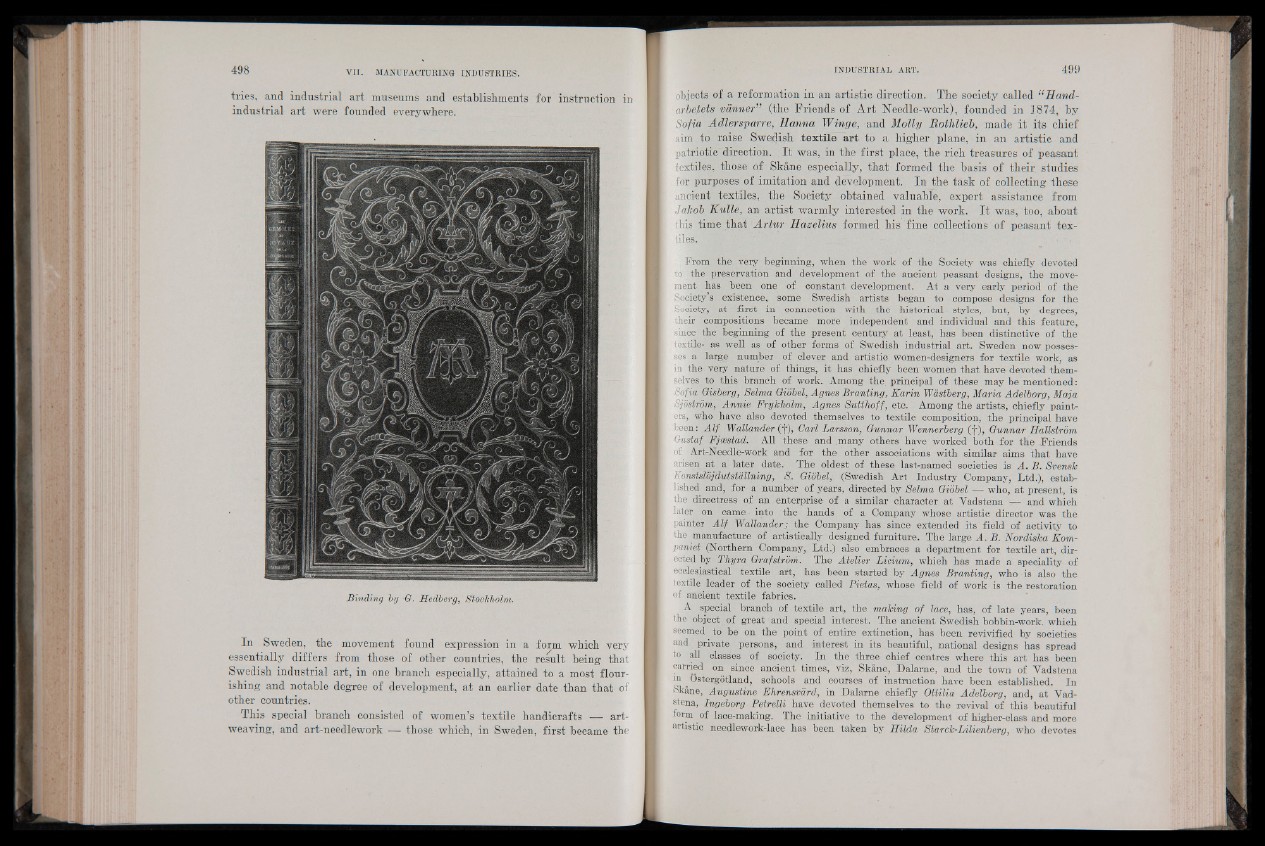
tries, and industrial art museums and establishments for instruction in
industrial art were founded everywhere.
Binding by G. Hedberg, Stockholm.
In Sweden, the movement found expression in a form which very
essentially differs from those of other countries, the result being that
Swedish industrial art, in one branch especially, attained to a most flourishing
and notable degree of development, at an earlier date than that of
other countries.
This special branch consisted of women’s textile handicrafts ■—- art-
weaving, and art-needlework — those which, in Sweden, first became the
objects of a reformation in an artistic direction. The society called “Hand-
arbejtets vänner” (the Triends of Art Needle-work), founded in 1874, by
Sofia Adlersparre, Hanna Winge, and Molly Rothlieb, made it its chief
aim to raise Swedish te x tile art to a higher plane, in an artistic and
patriotic direction. It was, in the first place, the rich treasures of peasant
textiles, those of Skäne especially, that formed the basis of their studies
for purposes of imitation and development. In the task of collecting these
ancient textiles, the Society obtained valuable, expert assistance from
Jakob Kulle, an artist warmly interested in the work. It was, too, about
this time that Artur Haeelius formed his fine collections of peasant textiles.
"V' i:; ; ^ ; .,:r j : - ••■■■ • - V .
From the very beginning, when the work of the Society was chiefly devoted
to the preservation and development of the ancient peasant designs, the movement
has been one of constant development. At a very early period of the
Society’s existence, some Swedish artists began to compose designs for the
Society, at first in connection with the historical styles,, but, by degrees,
their compositions became more independent and individual and this feature,
since the beginning of the present century at least, has been distinctive of the
textile- as well as of other forms of Swedish industrial art. Sweden now possesses
a large number of clever and artistic, women-designers for textile work, as
in the very nature' of things, it has chiefly been women that have devoted themselves
to this branch of work. Among the principal of these may be mentioned:
Sofia Gisberg, Selma Giöbel, Agnes Branting, Karin Wästberg, Maria Adelborg, Maja
Sjöström, Annie Frykholm, Agnes Sutthoff, etc, Among the artists, chiefly painters,
who have also devoted themselves to textile composition, the principal have
been: A lf Wallander (f), Carl Larsson, Gunnar Wennerberg (•}•), Gunnar Hallström
Gustaf Fjcestad. All these and .many others have worked both for the Friends
of Art-Needle-work and for the other associations with similar aims that have
arisen at a later date. The oldest of these iast-named societies is A. B. Svensk
Konstslöjdutställning, S. Giöbel, (Swedish Art Industry Company, Ltd.), established
and, for a number of years, directed by Selma Giöbel — who, at present, is
the directress pf an enterprise of a similar character at Vadstena — and which
later on came into the hands of a Company whose artistic director was the
painter A lf Wallander; the Company has since extended its field of activity to
the manufacture of artistically designed furniture. The large A. B. Nordiska Kom-
yaniet (Northern Company, Ltd.) also embraces a department for textile art, directed
by Thyra Graf ström. The Atelier Licium, which has made a speciality of
ecclesiastical textile art,' has been started by Agnes Branting, who is also the
textile leader of the society called Pietas, whose field of work is the restoration
of ancient textile fabrics.
A special branch of textile art, the making of lace, has, of late years, been
the object of great and special interest. The ancient Swedish bobbin-work, which
seemed to be on the point of entire extinction, has been revivified by societies
and private persons, and interest in its beautiful, national designs has spread
to all classes of society. In the three chief centres where this art has been
carried on since ancient times, viz, Skane, Dalarne, and the town of Vadstena
in ^ Östergötland, schools and courses of instruction have been established. In
Skäne, Augustine Ehrensvärd, in Dalarne chiefly Ottilia Adelborg, and, at Vadstena,
Ingeborg Petrelli have devoted themselves to the revival of this beautiful
form of lace-making. The initiative to the development of higher-class and more
artistic needlework-lace has been taken by Hilda Starck-Lilienberg, who devotes